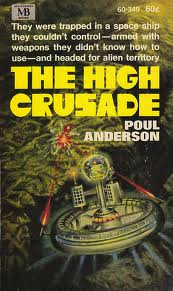Continuing to proceed through Poul Anderson's Going For Infinity (New York, 2002), we find the Technic Civilization History again represented, this time by a van Rijn story followed by an Ythrian story. These are out of chronological order but that does not matter here. In his introduction to the Ythrian story, Anderson does at last mention the History. He also tells us more about the conversation with John Campbell that led to the Ythrians.
Anderson had asked what kind of animals might be post-mammalian as mammals are post-reptilian and reptiles are post-amphibian. Campbell immediately suggested an anatomy that he thought "...would confer unprecedented cursorial ability..." (p. 185): former gills pumping concentrated oxygen into the blood. Anderson saw instead that, if the oxygen were to be pumped by beating wings, then a body big enough for intelligence would be able to lift itself in flight on an Earth-like planet.
Thus, the psychology, sociology and theology of intelligent, winged carnivores sharing a colony planet with human beings, some of whom join them in flight with anti-gravity belts, became a fascinating and substantial addition to Technic Civilization. Contrary to Campbell's original idea, Ythrians are graceful in flight but awkward on land.
Next, Anderson informs us that The High Crusade is one of his most popular works, with many editions in several languages, considered for filming by George Pal and in fact filmed, although apparently botched, by a German studio. Anderson admirably summarizes the absurd plot in order to introduce the short sequel, "Quest," which here represents the novel as "Death and the Knight" represents the Time Patrol, "The Horn of Time the Hunter" represents the Kith, "The Master Key" represents van Rijn and "The Problem of Pain" represents the Ythrians.
I will now reread "Quest."

No comments:
Post a Comment